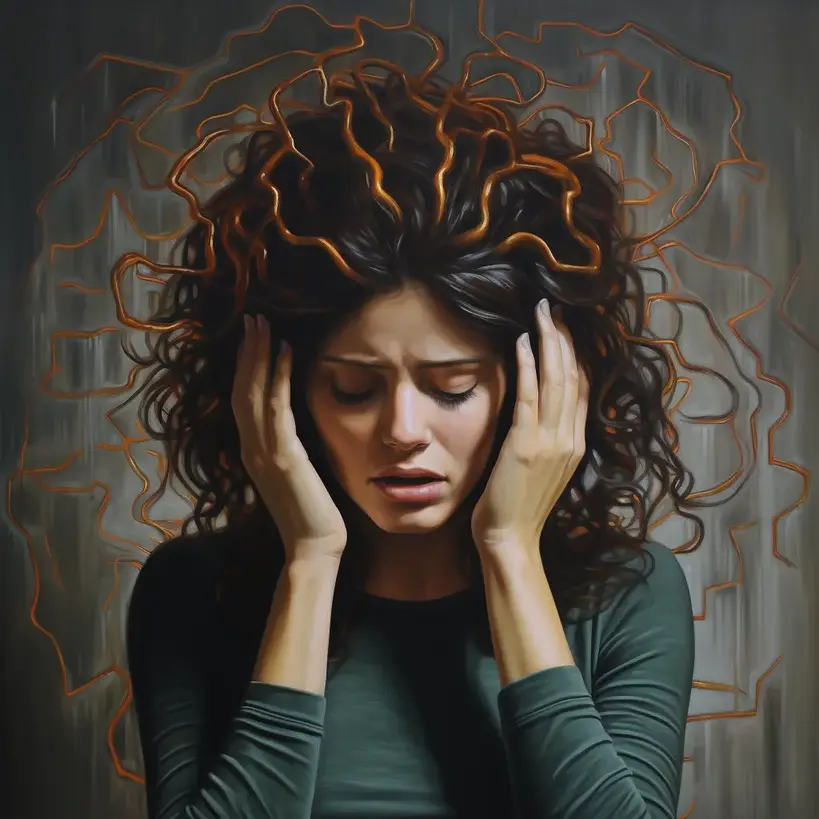Most of us have felt it at some point or another – a sudden chill, a poignant moment in a song, or even the resonating words of a gifted orator. The sensation is universally recognized: the hair on our arms or neck stands on end, and our skin erupts into a multitude of tiny bumps. This phenomenon is often referred to as “goosebumps” or “chicken skin.”
Across time and cultures, the seemingly simple act of our skin puckering into goosebumps has been infused with profound spiritual meaning. While modern science attributes these raised bumps to physiological reactions like cold or emotional stimuli, spiritual interpretations delve deeper, transcending the boundaries of our physical understanding.
The goosebumps phenomenon, in spiritual realms, is often viewed as a confluence of energies, emotions, and ethereal communications. This article seeks to introduce readers to the rich tapestry of spiritual insights surrounding the enigmatic experience of goosebumps, exploring how a mere physical reaction can be an intimate bridge between the tangible and the mystical.
Contents
- 1 I. Understanding the Basics: The Intriguing World of Goosebumps
- 2 II. When Skin Speaks: The Profound Spiritual Meaning Behind Goosebumps
- 3 III. Divine Chills: The Role of Goosebumps in World Religions
- 4 IV. The Emotional Rollercoaster: What Goosebumps Say About Your Feelings
- 5 V. Children and Goosebumps: A Peek into Innocence and Sensitivity
- 6 Final Thought
I. Understanding the Basics: The Intriguing World of Goosebumps
The phenomenon known to many as “goosebumps” – those tiny bumps that suddenly appear on our skin during moments of cold or intense emotion – is a captivating interplay of biology and experience. Let’s delve deeper into the science and triggers of this familiar, yet often overlooked, bodily response.
- The Biological Framework: At the heart of the goosebumps phenomenon lies a simple mechanism, universally termed “piloerection.” It’s a response that has its roots in our evolutionary history and remains a part of our physiological makeup today.
- Arrector Pili: The Unsung Muscles: Each of our hair follicles is equipped with a small, smooth muscle known as the arrector pili. These muscles, though minuscule, play a pivotal role in the appearance of goosebumps.
- Activation of the Reaction: When we encounter specific stimuli – whether environmental or emotional – these arrector pili muscles spring into action. They contract swiftly, pulling the hair follicle upright.
- The Resultant Appearance: The rapid contraction causes the surrounding skin to form a tiny mound, from which the hair stands on end. This gives the skin its characteristic ‘bumpy’ appearance, reminiscent of a goose’s flesh – hence the term ‘goosebumps.’
- Diverse Triggers, One Response: While a chilly breeze or a drop in temperature is perhaps the most common cause of goosebumps, they are by no means the sole triggers. Powerful emotions, ranging from the rush of adrenaline when frightened to the overwhelming awe of listening to a moving melody, can evoke the same physiological response.
- Evolutionary Roots: Historically, piloerection in many animals, including our ancestors, served as a mechanism to appear larger in the face of threats or to trap air and create an insulating layer in cold environments. While humans no longer rely on hair for insulation or intimidation, the reflex remains embedded in our biology.
In wrapping up, goosebumps serve as a fascinating reminder of our evolutionary journey. They bridge the gap between our ancient ancestors and modern humans, underscoring the complex tapestry of reactions and emotions that make us inherently human.
II. When Skin Speaks: The Profound Spiritual Meaning Behind Goosebumps
The phenomenon of goosebumps, or piloerection, goes beyond mere biological reactions to temperature or fear. In the realm of spirituality, these raised hairs and the tingling sensation that accompanies them often hold deeper meanings. Let’s delve into the spiritual insights associated with this fascinating bodily response.
1. Divine Connection
Throughout human history, the sensation of goosebumps has often been interpreted as a signal of a higher presence.
In many cultures and spiritual traditions, it’s believed that experiencing goosebumps during moments of prayer, reflection, or deep emotional connection can signify a touch or message from a higher power, guardian angels, or spirit guides. This sensation serves as a tactile confirmation of a connection with forces beyond our ordinary perception.
2. Energetic Shifts
The human body is more than just its physical components; it’s also a nexus of energetic fields. Spiritualists and holistic healers theorize that goosebumps can act as an indicator of changes or shifts in a person’s energy field.
This might occur when someone is profoundly aligned with their inner truth or when their intuition is particularly sharp. It’s like the body’s way of acknowledging that it’s tuned into a higher vibrational frequency.
3. Ancestral Memory
Have you ever felt a deep connection to a piece of music or been inexplicably drawn to a story or location? Some spiritual perspectives suggest that goosebumps in these moments are echoes of our ancestral memories.
The theory is that our DNA, beyond just encoding biological information, also carries the emotional and experiential imprints of our predecessors. Thus, certain stimuli might resonate with these imprints, evoking a deep emotional and physiological response that bridges the temporal distance between us and our ancestors.
4. Kundalini Awakening
Kundalini is a concept rooted in ancient Indian spiritual practices. It’s envisioned as a dormant serpentine energy at the base of the spine. When awakened, often through specific meditation and yogic practices, it rises through various energy centers or “chakras” in the body, leading to profound spiritual experiences and enlightenment.
One of the signs of a Kundalini awakening is the sensation of hair standing on end or goosebumps, perceived as the physical manifestation of this potent energy moving through the body.
5. Recognition of Truth
There are moments in life when a profound truth resonates deeply within us. Whether it’s a piece of wisdom shared by someone, a sudden epiphany, or a moment of deep introspection, these truths often come with a physical affirmation: goosebumps. Some spiritual teachings posit that this is our soul’s way of acknowledging and celebrating its alignment with the vast wisdom of the universe.
While these interpretations provide a spiritual perspective on the phenomenon of goosebumps, it’s essential to understand that individual experiences and beliefs will vary. Some might find deep spiritual meaning in these moments, while others may attribute them to purely physiological reactions. Whatever the interpretation, there’s no denying the power and mystery of the goosebumps experience.
III. Divine Chills: The Role of Goosebumps in World Religions
The phenomenon of goosebumps, or piloerection, is not just a biological reaction; it has often been mentioned, directly or indirectly, in religious texts and practices across various cultures. It is viewed by many as a manifestation of profound spiritual experiences or encounters with the divine. Let’s delve deeper into some of the mentions and interpretations of goosebumps in different religious contexts:
1. Hinduism
In Hindu scriptures, particularly in the epic tales of Ramayana and Mahabharata, there are references to the experience of hair standing on end. The Sanskrit term for this is “romaharshanam.” It often denotes a deep spiritual experience or an intense emotional reaction, especially when characters are in the presence of the divine or during moments of revelation.
2. Christianity
While the Bible doesn’t explicitly describe the phenomenon of goosebumps, many Christian mystics and saints have narrated feelings that might be likened to goosebumps during their profound spiritual encounters. The presence of the Holy Spirit, during Pentecost for instance, where the apostles felt a wind and “tongues of fire” might be metaphorically similar to the sensation of goosebumps or chills during deep spiritual experiences.
3. Buddhism
In some Buddhist scriptures and narratives, there are descriptions of devout practitioners experiencing physical reactions, which may include piloerection, during deep meditation or upon achieving certain insights. This is considered an indicator of the deep transformative power of the teachings and practices.
4. Indigenous and Shamanic Practices
Many indigenous cultures around the world interpret the sensation of goosebumps as an indication that one is in the presence of spirits or ancestors. In various shamanic practices, when one enters a trance or communicates with the spirit world, the sensation of hair standing on end is considered a physical affirmation of the presence or communication with spirits.
5. Sufism
Sufism, the mystical Islamic belief system, has numerous accounts of devotees feeling intense physical sensations during their deep spiritual practices, which include dance, music, and chants. While not always explicitly described as goosebumps, these sensations are indicative of the devotee’s connection to the divine.
6. Modern Interfaith and Spiritual Movements
Many modern spiritual practitioners, irrespective of their religious backgrounds, describe the sensation of goosebumps during moments of insight, meditation, or spiritual connection. It’s often viewed as a sign of alignment, confirmation of a truth, or the feeling of interconnectedness with the universe.
Conclusion
Throughout the ages, the sensation of goosebumps has transcended its biological understanding, finding its way into the sacred texts and practices of various religions. This universal experience, deeply rooted in our physiology, serves as a bridge between our physical and spiritual selves, making it a shared phenomenon across cultures and religions.
IV. The Emotional Rollercoaster: What Goosebumps Say About Your Feelings
Goosebumps, a seemingly simple physical response, often serve as a profound reflection of our emotional depths. These tiny skin elevations weave a narrative of our deepest feelings, ones that words often fail to capture. Let’s explore how various facets of our experiences – from melodies to memories – elicit this tactile testament to our emotional realm.
A. Music and the Soul: Why Certain Melodies Give Us Chills
- Universality of Music: Across cultures, timelines, and personal experiences, music stands as a universal language. It touches the soul, resonating with our core in a manner few other mediums can.
- Emotional Resonance: Certain chords, rhythms, or lyrics strike a chord within us, mirroring our internal emotions. This deep connection can stir profound feelings, manifesting as goosebumps.
- Biological Interplay: On a biological level, music releases dopamine, a neurotransmitter linked to pleasure and reward. When a particular piece aligns perfectly with our emotional state, this dopamine surge can lead to the familiar chill and subsequent goosebumps.
- Transcendental Moments: At times, music serves as a bridge to something beyond our immediate surroundings, creating a moment of transcendence. This overwhelming sense of being a part of something grander often reveals itself through goosebumps.
B. Nostalgia, Memories, and the Tactile Response
- Memory’s Embrace: Our minds house a plethora of memories, each carrying a unique emotional weight. When a sudden recollection emerges, especially one with intense feelings attached, our skin might ripple in response.
- Sensory Link: Often, past memories are linked to sensory experiences. A familiar scent, a deja vu moment, or even the rustle of old pages can catapult us back in time, eliciting goosebumps as silent witnesses to our journey.
- Yearning for Yesteryears: The ache of nostalgia, a bittersweet longing for moments passed, can often be intense enough to manifest as a tactile sensation, making our hairs stand on end.
C. Cinematic Experiences: When Stories Resonate Deeply
- Power of Storytelling: Cinema, in its essence, is a medium of storytelling. When these tales touch upon universal human experiences or personal narratives, they evoke strong emotional responses.
- Empathy on Screen: Watching characters undergo trials, tribulations, or moments of joy can mirror our feelings, leading to a surge of empathy. This intense connection can, at times, surface as goosebumps.
- The Cinematic Ambiance: The amalgamation of visuals, soundtracks, and compelling narratives creates an ambiance that can be overwhelming. When a scene deeply resonates, it leaves a lasting impact, often marked by the familiar prickling sensation on our skin.
In conclusion, while goosebumps are often dismissed as mere physiological reactions, they serve as poignant markers of our emotional landscape. Whether it’s the haunting beauty of a melody, the embrace of a memory, or the allure of a cinematic tale, these tactile responses provide a glimpse into the depth and richness of human emotions.
V. Children and Goosebumps: A Peek into Innocence and Sensitivity
In the tapestry of childhood, marked by wonder, discovery, and raw emotion, the appearance of goosebumps stands as a unique and poignant testament to a child’s delicate interaction with the world. The phenomenon, while rooted in biology, takes on an especially fascinating dimension when observed in the realm of the young. Let’s explore this intimate dance of innocence, sensitivity, and the ubiquitous goosebump.
- The Innate Biological Response: Just as with adults, the fundamental mechanics of goosebumps in children stem from the contraction of the arrector pili muscles. These tiny muscles, connected to hair follicles, cause hair to stand erect when they contract in response to stimuli.
- Heightened Sensitivity: Children, with their developing neural networks and untainted experiences, often exhibit a heightened sensitivity to external stimuli. Whether it’s a gentle caress of the wind, the first touch of snow, or the surprise of a cold splash, their bodies respond vividly, frequently resulting in goosebumps.
- Emotional Tides: A child’s world is an emotional rollercoaster. The joy of a new toy, the fear of a dark room, the overwhelming emotion of a heartfelt lullaby – these intense feelings, often new and unfiltered, can lead to the appearance of goosebumps. It’s a silent, yet powerful testament to their raw and uninhibited emotional journeys.
- Discovery and Awe: The world is a treasure trove of wonders for young eyes. Moments of sheer awe, like seeing a massive firework light up the night sky or hearing the roar of the ocean for the first time, can send shivers down their spine, manifesting as goosebumps.
- Protective Mechanism: From an evolutionary standpoint, goosebumps served to make creatures appear larger in the face of threats. In children, this vestigial reflex can be seen when they feel threatened or scared, even if the ‘threat’ is just a playful spook during a bedtime story.
- Empathy and Connection: Children, with their innate sense of empathy, can exhibit goosebumps when witnessing strong emotions in others. It can be a scene in a movie, a touching story read aloud, or even observing a parent’s emotional moment.
- Transitional Phases: As children grow and navigate the waters of puberty, hormonal fluctuations can also play a role in heightened sensations, making them more prone to experience goosebumps from both emotional and physical triggers.
In essence, while goosebumps are a universal physiological response, observing them in children offers a window into their pure, unadulterated experiences of the world. They remind us of a time when every emotion was magnified, every sensation was a discovery, and the line between the physical and emotional world was beautifully blurred.
Final Thought
The journey through the spiritual insights of the goosebumps phenomenon reveals a harmonious blend of biology, emotion, and ethereal understanding. It’s a testament to the human spirit’s ability to find deeper connections in seemingly ordinary experiences.
While science can explain the mechanics of goosebumps, our spiritual interpretations add layers of profound meaning, transforming these fleeting sensations into touchpoints with the universe, ancestral memories, and divine energies. In recognizing the spiritual dimensions of goosebumps, we are reminded of the delicate interplay between our physical existence and the vast, intangible cosmos beyond.
The goosebumps phenomenon, thus, stands as a beautiful reminder of the mysteries that lie at the intersection of the known and the unknown, urging us to seek, reflect, and marvel at the intricacies of our shared human experience.


